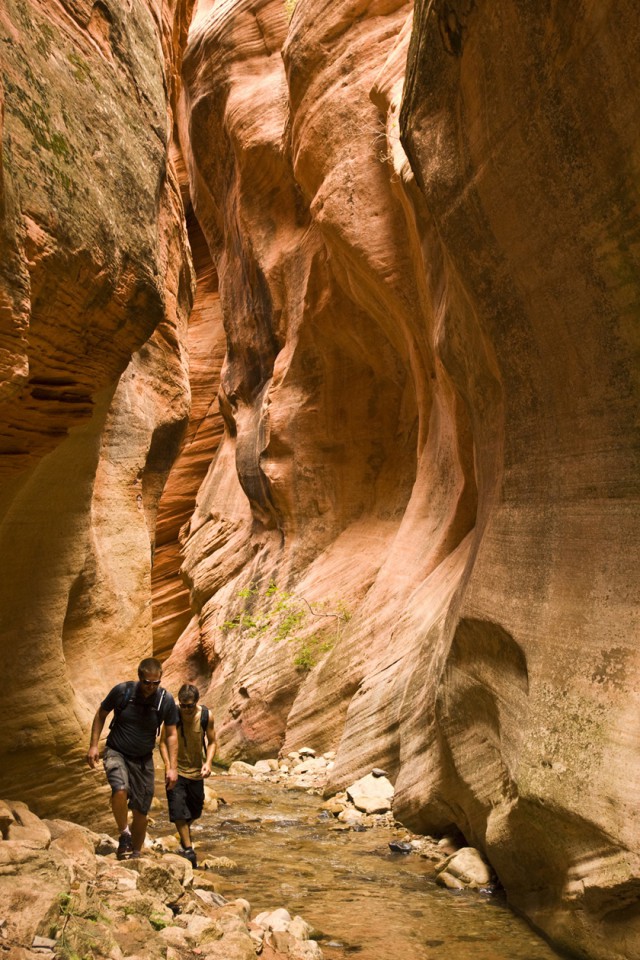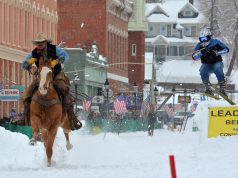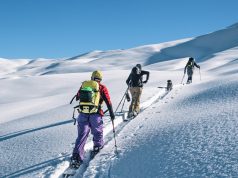
The hike started innocently enough: a well-trodden trail from a Utah campground near the small ski resort of Brianhead. Soon, though, we left the trail and started bushwhacking up a steep ridge. The terrain was rough. Loose rocks made progress difficult for those in front and dangerous for those behind, as the occasional boulder would bounce free and tumble towards the valley floor.
We crested the ridge and traversed along the steep face of yet another valley, dodging the fallen trunks of pine as the dry needles crackled beneath our feet. Below us, we could see the faint reflection of water, a thin band of wetness that coursed out of the Cedar Mountains, only a foot or so wide, and inches deep. We worked our way down to it, a hidden oasis in the dry climate. The stream led us down, over some red slickrock, remnants of the land’s geologic history. Then, suddenly, without warning, the stream vanished, into unseen depths, the gaping hole of a slot canyon hiding a netherworld of ferns and moss. From a precipice overlooking the waterfall, we could see the bottom, nearly 150 feet down, the first step in a series of steps we’d take as we left the surface of the planet behind and climbed into the depths.
Canyoneering has been around as long as there have been canyons and people to go into them. The antithesis of rock climbing, canyoneering is about going down. But that doesn’t mean it’s easy or without risk, as Aron “One Arm” Ralston can attest. Still, for those who enjoy a bit of adventure, canyoneering is about as accessible a sport as you can find. Basic trips don’t require much at all: Some footwear that can get wet and which will dry easily (and shorts to match) and a backpack with water, food and some first aid essentials are all that you need to get started. More intense trips await: The ability to handle ropes, do rappels and swim in icy waters, decent rock climbing skills and an immunity to claustrophobia allow serious participants to descend into places that are hidden from view. At its best, canyoneering takes you to spectacular grottos paved in the finest sand, the canyon walls painted in kaleidoscopic colors, the heat, noise and confusion of the Earth’s surface a forgotten memory. At its worst, canyoneering is a high-risk gamble with hypothermia, flash floods and Ralston-like mishaps where death can come quickly and without warning.
Today, though, we’re not being served up a helping of Ralston’s survival fries, but rather feasting on the kind of beauty and solitude that are the hallmarks of a good canyoneering adventure. Our first rappel is a big one. With beefy trees for anchors, we rig up the lines, double-check our harnesses and then clip in, walk backward in the stream and drop over the edge. A riot of green plants and algae grace the red canyon walls as we rappel into the gloom. The water splashes into our eyes and cools us off. Up there on the ridges, it’s 102 in the shade. Down here, it’s perfect. The rappel ends in a shallow pool with sandy banks. We pull the rope and, with it, our lifeline to the world above. From here, there’s only one way to go: down.
Most people think of mountains when they think of Colorado. But the state’s rugged geology, along with a privileged location on the Colorado Plateau (which it shares with Utah and Arizona), means that Boulder residents have easy access to a region that is unparalled in North America when it comes to canyons. In fact, the Colorado Plateau might be the best place in the world for canyoneering, with destinations such as Zion at the top of many hit lists.
Canyoneering can be as complex and difficult as you want it to be, and rock climbing skills are appreciated when you get into the tough stuff. Canyons are ranked according to a system that seems complex, but really isn’t too difficult to understand once you get the hang of it. This knowledge is power. Unlike the classic rock climbs of Yosemite or Eldorado Canyon, where one can look up at a face and quickly realize that the route is out of their league, canyons can be seductive and tricky. It’s easy to get into some of them, and nearly impossible to get out. And once you’re in, particularly if you rappel in, you are in, fully committed and, if a rescue is needed, in a place where it can be impossible for people on the surface to see where a victim is in trouble below.
Throw in water, sometimes running and sometimes sequestered in potholes and pools, and you have another danger. At the bottom of a narrow slot, a pool may never see the sun, making the risk of hypothermia great. Flash floods can appear even when the sun is out, fueled by thunderstorms miles away. And some pools, with their sloping walls of sandstone, are impossible to climb out of once you get into them.
Because of these risks, a good place to start a canyoneering education is at the American Canyoneering Association’s website. It’s here you’ll find a ranking system for canyons. Canyons are ranked on a scale of 1 to 4, with 1 being non-technical hikes and canyons with a grade of 4 requiring exposed free climbing, extensive use of ropes and expert anchor building skills. These numbers are augmented by the letters A to C4, which denote the water hazard of each canyon. Canyons in the A and B categories can be approached with confidence, particularly when conditions are dry. But C1 to C4 canyons have water, with C4 canyons being extremely dangerous even for experienced canyoneers who are strong swimmers.
Canyons are also given a risk assessment ranging from G (general public) to X and XX. In the latter two cases, errors in judgment or lack of ability will likely be punished with severe injury or death. The ACA also ranks canyons on a time/ commitment scale. Ranging from short (I) to multi-day (VI), the assessment grades how fast a person can travel through a specific canyon.
Finally, some canyons get the coveted S designation. S stands for “slot,” the most spectacular and narrow canyons but also some of the most difficult, dangerous and technical canyons to attempt.
Understanding this designation, as well as the other ways in which canyons are graded, is a key to pursuing the sport safely. The sad truth about canyons is that they kill people every year — people who exceeded their abilities, people who failed to comprehend exactly what they were getting into and people who didn’t bring enough gear or warm clothing and succumbed to the elements. Knowledge of the terrain and a healthy respect for the dangers that lurk in the depths of a canyon will help you avoid a similar fate.
We leave the sandy pool and the large atrium at the base of our first rappel and rappel again, traveling deeper into the slot. In the shade, the water is cold, and we’re happy we’ve brought extra fleece layers despite the heat of the day above. Splashing through pools and climbing over chockstones with filtered sunlight painting the walls myriad shades of red, the exit comes as a surprise, the sun too bright, the air too hot, as we return to life on the surface.
Respond: [email protected]














